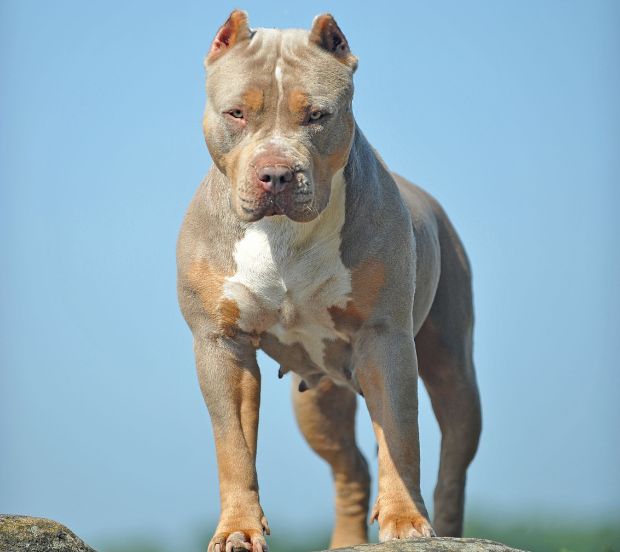Introduction to XL Bully Dogs
The XL Bully breed originated in the 1990s and early 2000s when breeders started crossing the American Pitbull Terrier and American Bulldog. The goal was to create a larger version of the popular American Bully breed with a stockier, heavily muscled build and loyal temperament. While XL Bullies resemble Pitbulls, they are distinctively bigger with males reaching over 20 inches tall at the shoulder and females over 19 inches.
XL Bullies have a thick, muscular body and a large, broad head with strong jaws. Their coat is short and smooth and comes in various colors like red, fawn, brown, gray, and black. White markings on the chest and paws are also common.
This breed was developed primarily as a family companion dog. XL Bullies are known for being extremely loving and loyal to their owners. They make excellent guard dogs and are very protective of their family. Despite their imposing size and strength, they have an easygoing temperament and thrive when included in family activities.
XL Bully Personality

XL bullies are known for having delightful personalities that make them excellent family companions. They are very affectionate and loyal dogs that thrive when they can spend lots of quality time with their human family members.
XL bullies really enjoy being around people. They are happy, friendly dogs that get along well with everyone. They love going for walks, playing games, or just hanging out with their favorite humans. Many XL bullies will follow their owners around the house just waiting for the next chance to receive some affection.
XL bullies can also be protective of their family members. Their loyalty and devotion prompts them to be watchful guardians, though they are not usually aggressive dogs. With proper socialization and training, XL bullies learn how to channel any protective tendencies into appropriate alert barking to let their owner know when someone is approaching.
Training XL Bullies
XL bully dogs respond very well to positive reinforcement training due to their high intelligence and eagerness to please. It’s important to start training and socializing them early on as puppies. Use rewards like treats, praise, and play to reinforce good behavior. Be patient and consistent.
XL bullies are smart and can learn commands, tricks, and proper manners rapidly. Focus initial training on potty training, crate training, basic obedience, and socialization. Expose them to new sights, sounds, people, and other dogs in a positive and controlled way during the critical socialization period under 4 months old. Proper socialization will prevent dog aggression issues later on.
While XL bullies aim to please their owners, they can have stubborn tendencies. Stay firm and calm when training them. Use positive reinforcement methods – never punishment. Establish yourself clearly as the pack leader. Work on obeying basic commands like sit, stay, come, down, and heel. Consistency and perseverance are key. Once an XL bully learns something properly, they will happily perform commands and tricks. Proper training and socialization from an early age will lead to a well-adjusted, happy XL bully that is a pleasure to own.
Exercise Needs
XL bullies require at least 30-60 minutes of exercise every day to stay physically and mentally healthy. As a high energy breed, they need more activity than the average dog.

Daily walks are a must for an XL bully. These powerful dogs enjoy having a job to do, so be prepared to provide them with adequate physical and mental stimulation.
XL bullies love activities like walking, hiking, jogging, or swimming. Long walks, playing fetch, or taking them to a dog park allows them to burn off their energy. Without enough exercise, XL bullies may resort to destructive behavior out of boredom.
Make sure to use a strong leash and properly fitted collar when walking an XL bully, as they can be strong pullers. Their exercise requirements may be lower in very hot or cold weather to prevent overheating or discomfort.
With their muscular build and eagerness to be active, XL bullies thrive when their owners commit to providing at least 30-60 minutes of daily activity tailored to their needs.
XL Bully Health
XL bullies can be prone to certain health issues, especially related to their brachycephalic (shortened) snouts and large, heavily muscled bodies.
Brachycephalic dogs like XL bullies can suffer from breathing difficulties, overheating, and other issues caused by the structure of their head and airways. Their short snouts combined with narrowed nostrils and elongated soft palates makes it harder for them to breathe normally.
XL bullies are also prone to joint problems like hip and elbow dysplasia due to their large size and muscle mass. Responsible breeding can help reduce the chances of joint issues. Providing joint supplements and maintaining a healthy weight is important.
The average lifespan of an XL bully is between 10-14 years. With proper care, regular vet visits, a healthy diet, and exercise, XL bullies can live happily within this range. Being aware of their potential health predispositions allows owners to better care for their XL bully.
Grooming
XL bullies have a short, smooth coat that requires minimal grooming. Their short coat makes grooming easy compared to other breeds. You can maintain their coat with occasional bathing using a mild dog shampoo and regular nail trimming.

Bathe your XL bully every few months or when they get dirty. Use a moisturizing dog shampoo to keep their skin and coat healthy. Avoid over-bathing, as this can dry out their skin. Pay attention to skin folds where moisture can accumulate.
Trim nails regularly to avoid overgrowth and cracking. Get your XL bully comfortable with having their paws handled and nails trimmed from a young age. Long quicks can make nail trimming more difficult.
Brush teeth weekly to maintain dental health. Daily is ideal. Their short coat means they shed minimally and don’t require regular brushing.
Clean and check ears weekly for signs of infection. Ear cleaning helps prevent infections. Look inside ears for redness, inflammation, or discharge.
With minimal grooming needs, XL bullies are relatively easy keepers. Their short coat makes grooming fast and straightforward.
Dietary Needs
XL Bullies do not have any particularly special nutritional needs. They should be fed a high-quality dog food and given 3-4 cups daily. Since XL Bullies can be prone to obesity, it’s important to monitor their weight and adjust food amounts accordingly. Overweight dogs are at risk for joint issues, breathing problems, and other health concerns.
Some tips for feeding your XL Bully include:
- Follow portion guidelines on the dog food packaging as a starting point.
- Weigh out food rather than eyeballing portion sizes.
- Use a consistent feeding schedule rather than free-feeding.
- Substitute low-calorie vegetables like green beans if your dog needs to lose weight.
- Make sure fresh water is always available.
With appropriate diet and exercise, your XL Bully can maintain a healthy weight and live an active, happy life!
Finding an XL Bully
When searching for an XL bully puppy, it’s important to find a reputable breeder and avoid puppy mills or backyard breeders. Reputable XL bully breeders will do health and temperament testing on their breeding dogs to ensure healthy, stable puppies. They will also let you meet the puppy’s parents and see where the puppies are raised.

Beware of breeders advertising XL bullies at very low prices or who are willing to ship puppies. This can be a sign of irresponsible breeding practices. A well-bred XL bully from health tested parents will cost $2,000 to $3,500 USD on average.
Take time finding the right breeder and prepare to be put on a waitlist. Reputable XL bully breeders often have long waitlists for their puppies. The extra time and cost ensures you receive a happy, healthy XL bully companion.
Common Questions
XL bullies are known for being great family dogs. They love people and are very friendly and affectionate. However, like any breed, proper socialization and training is important. With an XL bully, it’s especially important to establish yourself as the pack leader from a young age so they respect you. Overall though, they make wonderful pets and companions for families when trained properly.
In terms of size, XL bullies typically range from 80-120 lbs for males and 70-100 lbs for females, depending on their specific bloodlines. Some may be even larger. They are a taller, heavier, and more muscular bully breed. Make sure you have the space and ability to properly handle a large dog before committing to an XL bully.
XL bullies have a reputation for being more docile than some other bully breeds. However, some can still exhibit dog aggression, especially intact males. Proper socialization and training from an early age is key to curbing any unwanted aggression. XL bullies that come from reputable breeders and are raised in a loving home are typically very friendly, stable dogs. But supervision is still recommended when interacting with strangers or other animals.
The Ideal Home
The XL bully is a strong, energetic breed that does best in an experienced home prepared for an active dog. These dogs were originally bred for work and sports, so they thrive when given jobs to do. While XL bullies can adapt to apartment living if sufficiently exercised, a house with a fenced yard is ideal. This allows them space to run around and play.
Families interested in training and exercising their XL bully daily make the best match. These dogs are eager to please and highly intelligent when motivated. With positive reinforcement training, they can learn advanced commands and tricks. But without enough activity, XL bullies may become bored and destructive. Regular walks, play time, obedience practice, and interactive toys are musts.
While XL bullies love children, their size and strength require supervision around little ones. These affectionate dogs tend to do best with older, dog-savvy kids who understand how to properly interact with them. With early socialization and training, XL bullies can thrive in homes with kids. But families prepared to meet their high exercise needs while also managing their interactions provide the ideal situation.